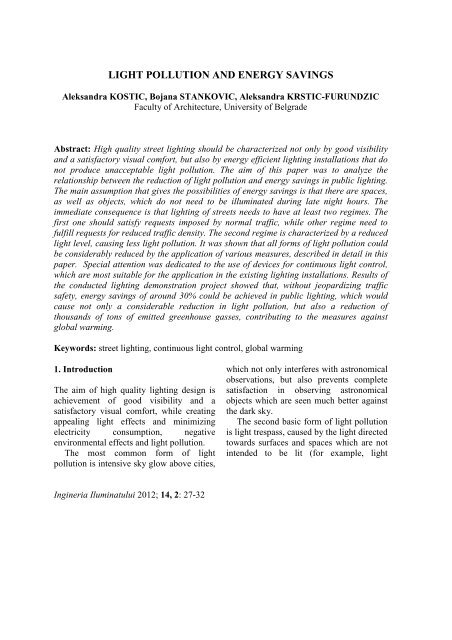Untitled - Journal of Lighting Engineering
Untitled - Journal of Lighting Engineering
Untitled - Journal of Lighting Engineering
You also want an ePaper? Increase the reach of your titles
YUMPU automatically turns print PDFs into web optimized ePapers that Google loves.
LIGHT POLLUTION AND ENERGY SAVINGS<br />
Aleksandra KOSTIC, Bojana STANKOVIC, Aleksandra KRSTIC-FURUNDZIC<br />
Faculty <strong>of</strong> Architecture, University <strong>of</strong> Belgrade<br />
Abstract: High quality street lighting should be characterized not only by good visibility<br />
and a satisfactory visual comfort, but also by energy efficient lighting installations that do<br />
not produce unacceptable light pollution. The aim <strong>of</strong> this paper was to analyze the<br />
relationship between the reduction <strong>of</strong> light pollution and energy savings in public lighting.<br />
The main assumption that gives the possibilities <strong>of</strong> energy savings is that there are spaces,<br />
as well as objects, which do not need to be illuminated during late night hours. The<br />
immediate consequence is that lighting <strong>of</strong> streets needs to have at least two regimes. The<br />
first one should satisfy requests imposed by normal traffic, while other regime need to<br />
fulfill requests for reduced traffic density. The second regime is characterized by a reduced<br />
light level, causing less light pollution. It was shown that all forms <strong>of</strong> light pollution could<br />
be considerably reduced by the application <strong>of</strong> various measures, described in detail in this<br />
paper. Special attention was dedicated to the use <strong>of</strong> devices for continuous light control,<br />
which are most suitable for the application in the existing lighting installations. Results <strong>of</strong><br />
the conducted lighting demonstration project showed that, without jeopardizing traffic<br />
safety, energy savings <strong>of</strong> around 30% could be achieved in public lighting, which would<br />
cause not only a considerable reduction in light pollution, but also a reduction <strong>of</strong><br />
thousands <strong>of</strong> tons <strong>of</strong> emitted greenhouse gasses, contributing to the measures against<br />
global warming.<br />
Keywords: street lighting, continuous light control, global warming<br />
1. Introduction<br />
The aim <strong>of</strong> high quality lighting design is<br />
achievement <strong>of</strong> good visibility and a<br />
satisfactory visual comfort, while creating<br />
appealing light effects and minimizing<br />
electricity consumption, negative<br />
environmental effects and light pollution.<br />
The most common form <strong>of</strong> light<br />
pollution is intensive sky glow above cities,<br />
Ingineria Iluminatului 2012; 14, 2: 27-32<br />
which not only interferes with astronomical<br />
observations, but also prevents complete<br />
satisfaction in observing astronomical<br />
objects which are seen much better against<br />
the dark sky.<br />
The second basic form <strong>of</strong> light pollution<br />
is light trespass, caused by the light directed<br />
towards surfaces and spaces which are not<br />
intended to be lit (for example, light
















